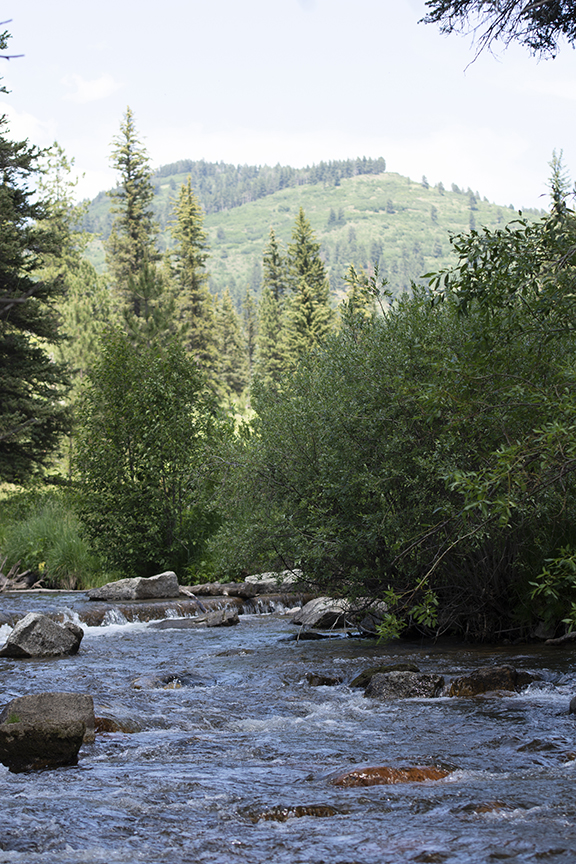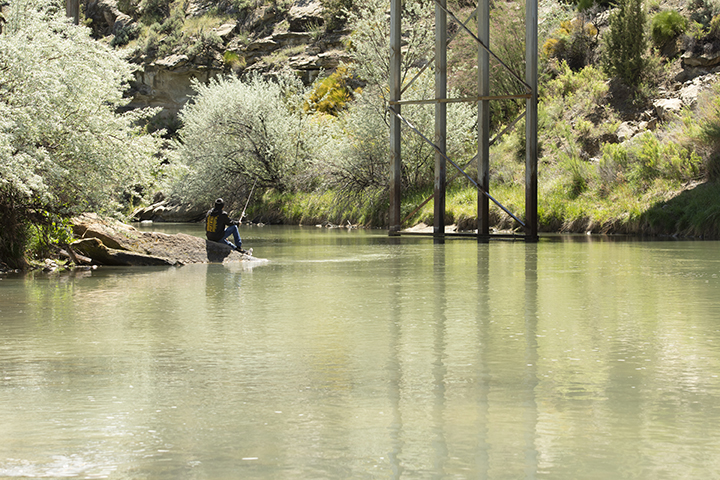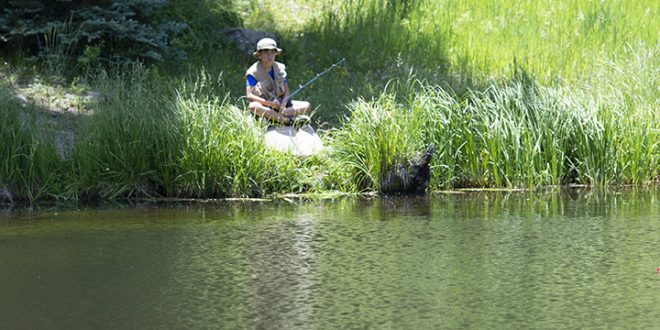Fishing a river does not require much gear and can easily be done from the bank or wading. Children should use shorter rods and smaller, lighter reels. Five-and-a-half-foot rod-and-reel combos are inexpensive and are great for kids ages 7-12.
Teaching kids how to fish takes time. I recommend fishing for short periods, 30 minutes or so with short breaks; don’t forget to bring snacks. Stay close to your kids, as things will go wrong. Snags, tangles and losing tackle and bait are part of the process. Try not to show frustration as mistakes are to be expected and are a significant part of learning
As the adult, you will not be doing much fishing. You will be baiting hooks, tending to tackle issues and hopefully unhooking fish. If you do hook a fish, let your child reel it in and experience catching a fish.
Remember, fish are predatory and are always in search of food. Fish themselves can be eaten by other wildlife, so staying safe, preserving energy and hiding is a major priority. Teaching your kids how to study a river or stream to locate possible hiding spots for fish will sharpen their fishing skills and lead to a lifetime of angling success.

OBJECTIVE: Kids will be able to:
- Learn how to approach a river carefully.
- Learn how to divide a river into small sections.
- Learn how to take the time to study the water.
- Learn how to identify spots in a river that potentially hold fish.
- Learn how to fish certain features in a river.
METHOD: Under adult supervision, kids will learn how to approach a river carefully and “read” the water, looking for likely places that fish will be holding. They will then attempt to catch fish.
MATERIALS: A 5 ½-foot fishing rod, closed-face reel, bait, size 8 hooks, split shot, small bobber and a landing net are needed.
OVERVIEW: Taking the time to study the water when fishing a river will help beginning anglers learn where fish like to hold. Divide the river into small sections and help the kids look for features in a river where fish are likely present. Have the kids approach the river carefully and drop their lines in the water. Over time, these beginning anglers will develop more skill, confidence and better fishing techniques that will lead to greater success.
APPROACH THE RIVER: Always approach a river carefully and slowly so as not to spook the fish; they are very sensitive to movement and shadows. Stand 10 to 15 feet from the bank and take the time to study the water. Do not let your shadow hit the water and remain as quiet and hidden as possible. As well, do not wear bright clothes — fish can see color.

WHERE DO FISH “HOLD” IN THE WATER?
- POOLS – Pools are a great place to find fish in a river. Pools are places where the river current slows down and the water gets deeper. Pools attract fish for protection in the deeper depths. These pools also help keep them cooler and allow them to get out of a fast-flowing current to save energy.Fish a pool from downstream and make a few casts around the entire pool. Start by casting into the current in the pool immediately in front of you. Next, cast into the current at the front and middle of the pool and let your bait dead drift through the pool; start reeling when you’re about halfway through it. If the fish do not bite, speed up your retrieve. Finally, drop your line into the backside of the pool. Again, stand downstream of the pool and cast up into the middle. Let your bait drift until it gets to the faster-moving current, then start reeling in faster.
- UNDERCUT BANK – Undercut banks are excellent places for trout to hide and wait for food to float by. “Cut-banks” are spots where the grassy bank has been undercut by the current, especially along the outer bends in the stream. This is a perfect spot for trout to hide as cut-banks offer slow currents, food, safety and shade.To fish an undercut bank, be careful with your casts and drift your bait with the current as close as possible to the edge of the bank. Trout hiding in undercut banks are particularly prone to striking inline, which should be skipped under the bank.
- LARGE ROCKS – Swimming in a fast-flowing stream can be difficult, so trout look for places to hide away from the fast currents. A boulder or large rock can break and slow the force of the current and create a small “pocket” on the downstream side of the rock. This is a perfect place for fish to hide. Trout usually hide behind or on either side of the rock facing upstream, waiting for food to flow by.To fish around large rocks, get close to the side of the pocket and cast upstream from these rocks. Drift your bait into the pocket where it will get sucked deep into the water where fish are hiding.
- WOOD JAMS – Fallen trees and log jams form pools and are great places for trout to wait in ambush for prey. Wood piles also slow the current down and offer shade and a safe place for fish to hide.Fish carefully around wood jams; it is easy to get caught up in them. Make a cast and let the current pull the bait as close as you can get it to the jam without snagging it, then start reeling the line in across the current. You can also cast upstream and dead-drift your bait to the wood jam.
- SHADE – Trout do not like to swim in the open sun and will find places to hide. Trout seek out shade, which helps keep the fish cooler but also makes them more challenging to see in the water. Remember, the fish will see you before you see them, so fish the shade quietly and try not to be seen.
- EDDY – An eddy is the part of a river where a sharp bend, log jams or large rocks block the water’s flow and change its direction. Just behind and downstream of one of these structures, the water will swirl in a circular direction before it straightens out again. Trout love eddies because they collect and trap drifting insects, making them easier to catch.Cast your line where foam flowing in the main current meets the swirling water.
- SEAMS – A seam is where two currents of water meet. Seams are caused by a change of speed in a current where the water’s flow is partially interrupted by an obstacle in the water, usually a rock, woodpile or other structure. You will see the two adjacent currents flowing together, with one current flowing slower than the other.Cast your line upstream in the faster current right next to a slower current and drift your bait. Fish like to hide in the slower current facing upstream, waiting for the faster current to bring food floating by so they can dart out, eat the meal and dart quickly back into the slower current to wait for more food to float by.
- RIFFLES – Riffles are part of the river where the water is usually shallow, turbulent and moving fast over a rocky bottom, which can provide protection for the fish. Even though fish prefer calmer waters, they will spend time in a riffle where food can be plentiful, and the foam lines give fish some cover.Fish can be sitting in the fast water and go a few feet in either direction to catch food floating by. The best method for fishing riffles is to dead drift. Let your bait float down the river and wait for a strike. Try to minimize your drag. If your line is ahead of your bait drifting down the river, you won’t catch fish. To avoid your line getting ahead of your bait, hold your rod tip higher to keep the line out of the current.
- WATERFALLS – The pools below both big and small waterfalls can be great places to look for trout. The water flowing over falls and into these pools continuously brings food to fish waiting below. The turbulent water on the surface of a pool protects and conceals everything beneath, providing excellent cover from predators and providing an area directly under the fall with little to no

Remember, the best places to locate trout in moving water are:
- Where there is a change in current speed, fish will sit in the slower water and pull food from the faster current. Look for the foam line on the sides of the current.
- Where there is some form of protective structure for the fish to hide, such as a rock, log or undercut bank. Trout usually hold in slower water, with easy access to faster water where they can dart out quickly, eat any food floating by and dart back into their holding spot.
- Deeper water three or more feet deep, depending on stream size. Trout like deeper water because it will protect them from many predators, and the water temperature is cooler near the bottom.
By learning how to divide a river or stream into smaller sections, you can teach your kids how to read a river and, over time, sharpen their angling skills.
 New Mexico Wildlife magazine Conserving New Mexico's Wildlife for Future Generations
New Mexico Wildlife magazine Conserving New Mexico's Wildlife for Future Generations
